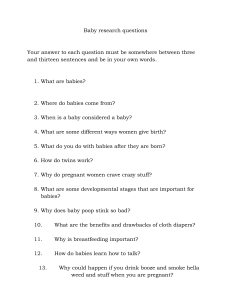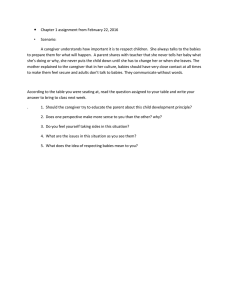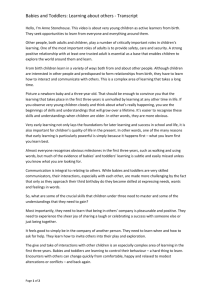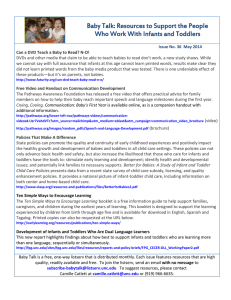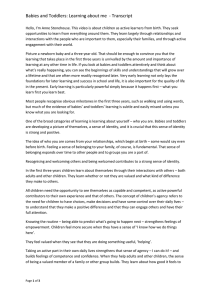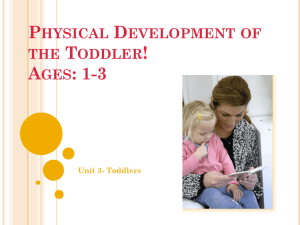Sharing books with your child (docx
advertisement
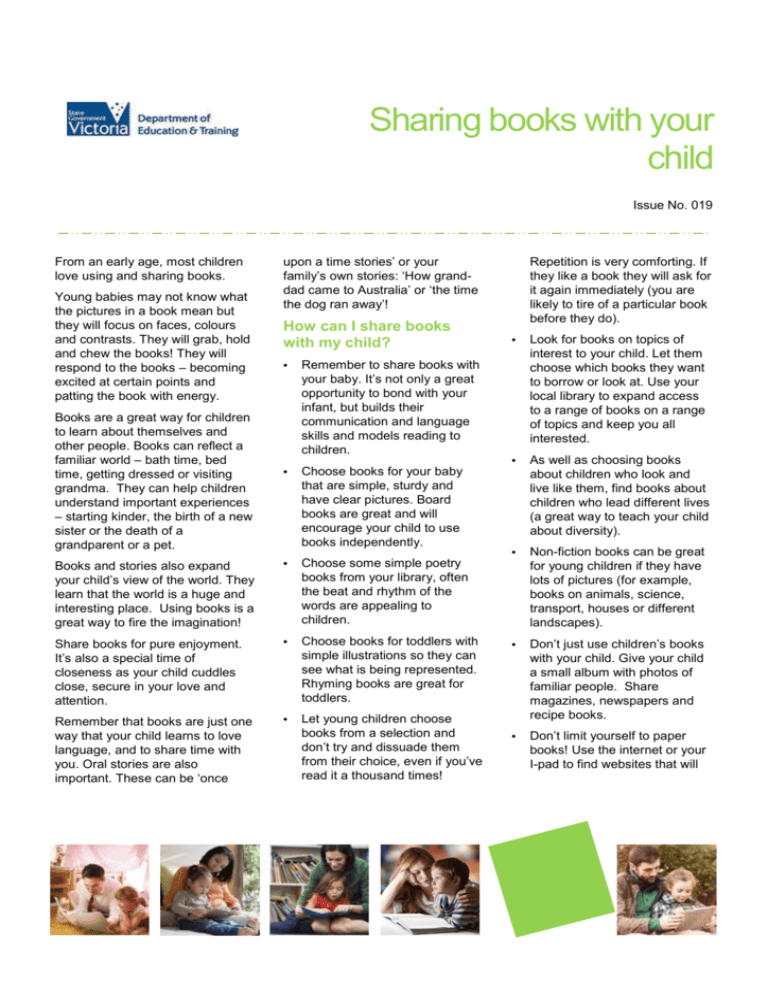
Sharing books with your child Issue No. 019 From an early age, most children love using and sharing books. Young babies may not know what the pictures in a book mean but they will focus on faces, colours and contrasts. They will grab, hold and chew the books! They will respond to the books – becoming excited at certain points and patting the book with energy. upon a time stories’ or your family’s own stories: ‘How granddad came to Australia’ or ‘the time the dog ran away’! How can I share books with my child? Remember to share books with your baby. It’s not only a great opportunity to bond with your infant, but builds their communication and language skills and models reading to children. Choose books for your baby that are simple, sturdy and have clear pictures. Board books are great and will encourage your child to use books independently. Books and stories also expand your child’s view of the world. They learn that the world is a huge and interesting place. Using books is a great way to fire the imagination! Choose some simple poetry books from your library, often the beat and rhythm of the words are appealing to children. Share books for pure enjoyment. It’s also a special time of closeness as your child cuddles close, secure in your love and attention. Choose books for toddlers with simple illustrations so they can see what is being represented. Rhyming books are great for toddlers. Remember that books are just one way that your child learns to love language, and to share time with you. Oral stories are also important. These can be ‘once Let young children choose books from a selection and don’t try and dissuade them from their choice, even if you’ve read it a thousand times! Books are a great way for children to learn about themselves and other people. Books can reflect a familiar world – bath time, bed time, getting dressed or visiting grandma. They can help children understand important experiences – starting kinder, the birth of a new sister or the death of a grandparent or a pet. Repetition is very comforting. If they like a book they will ask for it again immediately (you are likely to tire of a particular book before they do). Look for books on topics of interest to your child. Let them choose which books they want to borrow or look at. Use your local library to expand access to a range of books on a range of topics and keep you all interested. As well as choosing books about children who look and live like them, find books about children who lead different lives (a great way to teach your child about diversity). Non-fiction books can be great for young children if they have lots of pictures (for example, books on animals, science, transport, houses or different landscapes). Don’t just use children’s books with your child. Give your child a small album with photos of familiar people. Share magazines, newspapers and recipe books. Don’t limit yourself to paper books! Use the internet or your I-pad to find websites that will interest your child. Many online stories encourage interaction. As you share books, involve your child: o Let them turn the pages. Read the story at your child’s pace. o Encourage your child to talk about the book – what do they notice, what do they like? o Encourage your child to sing or clap along if a book has strong rhythms. o Let them finish sentences if it’s a book they know As your child gets older, you will be able to read actual stories with them, focusing more on the words, sentence and story structure. Anticipating what might happen next in the story is a great way of involving and engaging your child in a conversation about the characters and plot. Related links Raising Children’s: Reading with babies from four months Reading and storytelling with babies and children You may also like to read You may also like to read other titles in this series: Screen time Encouraging your child to be active Everyday learning Learning through play Encouraging your child’s strengths and interests Other related newsletters can be found at www.education.vic.gov.au If English is not your first language, also choose books in your home language. This helps your child to connect with their family culture, and extends their language skills in their home language and in English. Sharing books with your child page 2

